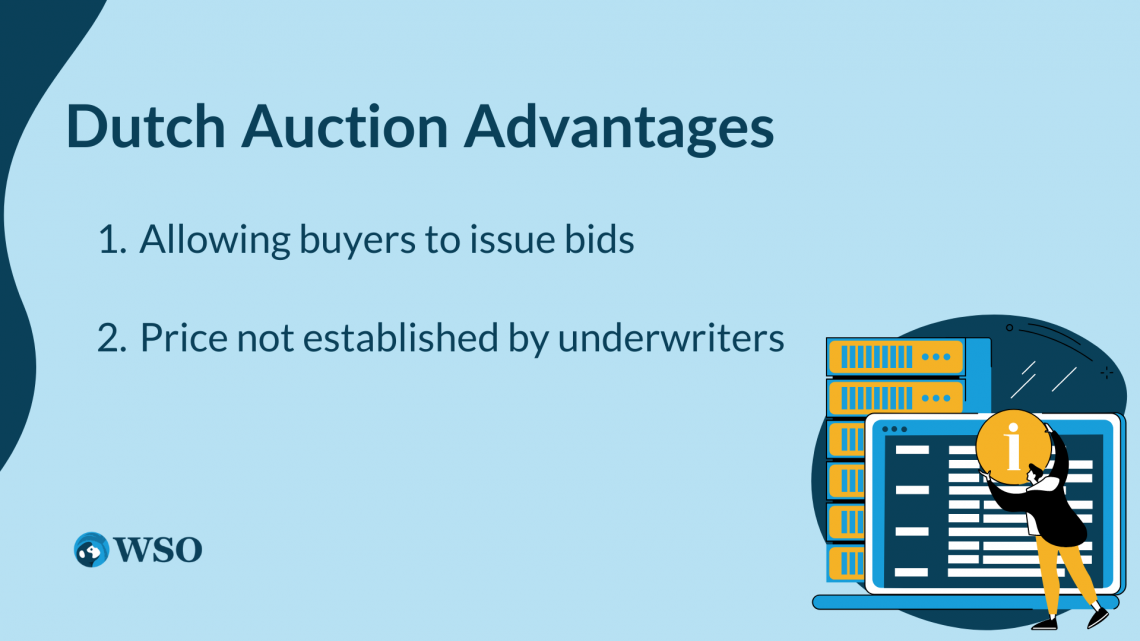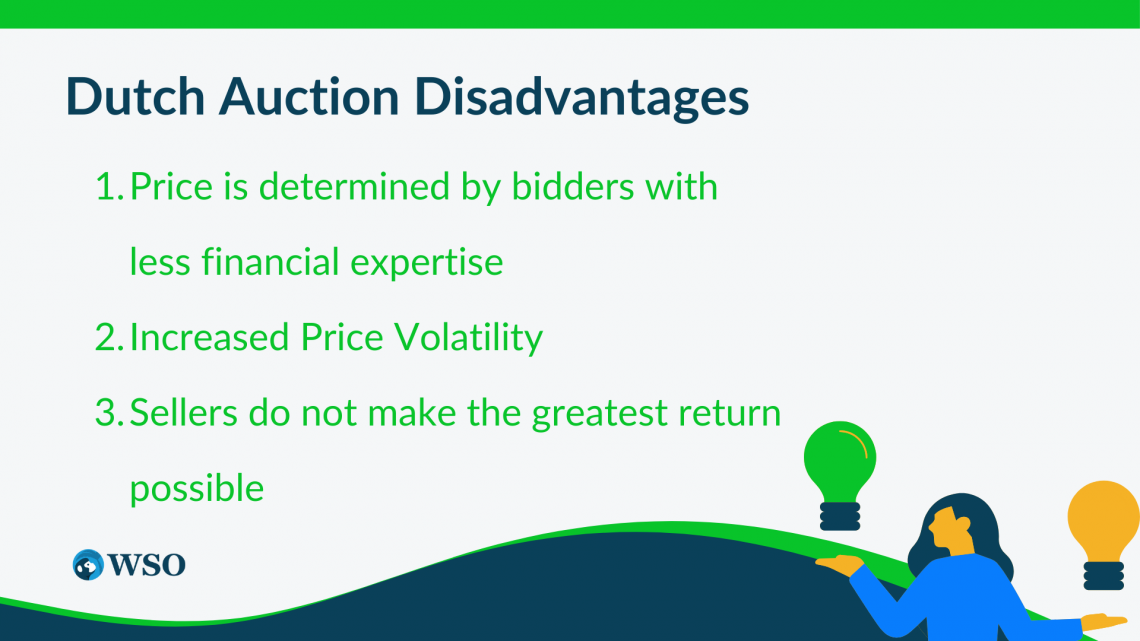Dutch Auction
Form of auction characterized by a downward descent in price until the item or asset is sold
A descent in price characterizes a Dutch auction until the item or asset is sold. It was named for the structure employed in Holland during the 1600s to sell tulips quickly in a volatile market.

This form of auction can be used to sell a single good. But more commonly, it sells many assets like Treasury bills, bonds, and notes.
In its single-item variation, the auctioneer is typically replaced by a mechanism that lowers the price incrementally until someone accepts the price. In this format, whoever bids first wins the auction.
Because this structure avoids the competitive bidding process of traditional auctions, it is much faster than the common English auction. However, the Dutch auction could be better because people bid according to how much they believe others will pay.
For example:
Consider if one person was willing to pay $500 for an antique dinner table but believed the other participants were only willing to bid $200. He would likely bid only slightly higher than $200. However, if he miscalculates, he could lose the entire auction.
Key Takeaways
- Dutch auctions target the highest price at which all of the assets can be sold
- Bids are filled from the highest to the lowest until everything is sold
- The highest bids are prioritized first
- Depending on the asset in question, the types of bids and how they are ranked will differ
- This structure does not capture the entire consumer surplus because it charges a single price
- Lack of knowledge and expertise may lead to poor valuations of an asset’s intrinsic value
- Initial public offerings hosted in this format improve transparency and boost participation by smaller investors
- Google’s IPO illustrated the price stability that can be achieved through fair valuations
Dutch Auction Format
Let’s discuss the other, more common format of the Dutch auction. Compared to traditional ways of selling assets, the Dutch auction allows for more widespread participation in the pricing process.

While traditional vendors typically price their assets with the help of experts like investment bankers who are well-versed in the valuation procedure, this structure allows consumer demand to set a fair price.
Essentially, the seller sets the quantity of a particular asset they want to sell along with a reservation price. This price represents the lowest amount that they would sell it for, protecting low prices from weak demand.
Then, prospective buyers submit the quantity they seek to buy in addition to a price they are willing to pay. These submissions are sorted by price from highest to lowest, filling orders from the top down until the desired quantity is sold.
The entire stock is sold at the same price. Namely, they are sold at the lowest price of all orders filled. This ensures that buyers pay only what they said they would pay.
Dutch Auction Explained
The Dutch auction is essentially a process for finding the highest price at which all assets can be sold. In both formats—regardless of whether you are selling one product or many—the price moves from high to low until the goods are sold.

This is done in the hopes that it will produce the highest price possible while selling those assets. The type of asset sold in this format can vary, ranging from antiques to stocks and Treasury bonds.
For antiques, for example, each item is typically sold individually, and the bidding occurs separately for each item.
However, this process differs slightly between stocks and Treasury bonds. To ensure they sell as much of the asset as possible, the seller accepts many bids to maximize their profits.
NOTE
The bidding process is much faster in Dutch auctions than in traditional English auctions because the auction ends as soon as the first bid is placed.
They do this because it is not feasible for one buyer to purchase all 4 million shares in a company’s IPO, for example. Likewise, the United States Treasury sells bonds via this process, allowing prospective buyers to bid on bond yield rates instead.
In this case, the government would accept the lowest yield rate, allowing it to sell its bonds to maximize profit.
When such a price is found, the seller sells the entirety of its stock at that price. As a result, it is in people’s best interests to bid however much they are willing to pay because they will gain from it if the resulting price is less than or equal to that reservation price.
However, people can miscalculate. When people arrive at a wrong estimate of an asset’s intrinsic value, the Dutch auction may lead to imperfect outcomes.
Dutch Auction Example
Let’s consider the example of a Dutch auction during a company's initial public offering process. Assume that the company is trying to sell 800 shares of stock at a reservation price of $25 per share.

Now, let’s examine the buyers. The four prospective buyers are listed below, with the number of shares they seek to purchase and the price they offer per share.
- Buyer A: 150 shares at $50 per share
- Buyer B: 300 shares at $30 per share
- Buyer C: 200 shares at $35 per share
- Buyer D: 450 shares at $70 per share
From the company's perspective, they will first organize the preceding buyers by their willingness to pay, prioritizing the buyers who offer the highest price.
- Buyer D: 450 shares at $70 per share
- Buyer A: 150 shares at $50 per share
- Buyer C: 200 shares at $35 per share
- Buyer B: 300 shares at $30 per share
Afterward, they will fill the orders, starting with the top of the list, which has the most prioritized buyers, and moving downwards. Finally, with 800 shares to sell, Buyer D will be allotted the 450 they wish to purchase.
Next, Buyer A is allotted 150 shares, bringing the total to 600 shares sold. Finally, buyer C’s 200 shares are filled last, exhausting the entire supply of shares to be sold.
While Buyers D and A offered high prices, they purchased the number of shares they requested at the lowest successful bid, namely, at $35 per share.
Buyer B does not get to purchase shares because their bid was lower than the other bids, deprioritizing their offer from the seller's perspective.
What if the offers did not add up to 800 800 shares? Consider the following changes.
- Buyer D: 450 shares at $50 per share
- Buyer A: 150 shares at $50 per share
- Buyer C: 200 shares at $50 per share
- Buyer B: 300 shares at $50 per share
In this case, everyone is prioritized equally because they all offered the same price of $50 per share, above the reserve price. However, the total number of shares demanded exceeds the amount offered.
The four buyers seek 1100 shares, but only 800 are offered. In this situation, the company is tasked with finding a way to allocate the shares fairly. They may do so by granting everyone a fixed percentage of their shares.
For example, 800/1100 is around 73%, so the company could offer to sell each person 73% of the shares they requested.
Dutch Auction Advantages and Disadvantages
This format has several advantages and disadvantages due to its accessibility. For example, the price set by the demand for the asset can be a strength and a weakness.

The Advantages of this format are:
1. Allowing buyers to issue bids
By allowing buyers to issue bids for what they believe is a fair price and sorting them by their bids, the auction allocates the assets to those who value them most, assuring that those who value the asset the most and can pay a high price for it can obtain it.
Prospective buyers bid prices they are willing to pay for the item. As a result, the ending price should be a decent representation of the asset's intrinsic value.
2. Price not established by the underwriters.
The asset price is not established by the underwriters, who have a financial interest in underpricing the item; hence this procedure provides greater transparency.
The Disadvantages are:

1. Bidders with less financial expertise determine the price
Greater transparency is undermined because bidders must be more educated than investment bankers, whose professional experience and expertise can help them discover a more accurate price.
Smaller investors have fewer resources at their disposal compared to investment bankers and institutions. Unfortunately, this also means they may need to learn all the information about a company. This and less detailed analysis beforehand can lead to poor valuations.
2. Increased price volatility
In addition, bidders who miscalculate their offers in the context of an IPO may contribute to increased stock price volatility if they sell quickly afterward to cut their losses.
3. Sellers need to make the greatest return possible.
Another area for improvement of this format is that it does not capture the entire consumer surplus. In other words, the corporation could have raised more money if they charged each buyer the most they were prepared to pay.
In a Dutch auction, the final price is the lowest of all accepted offers; therefore, buyers willing to pay more than the final price benefitted unexpectedly. From the seller's perspective, this is an unrealized profit.
Why would a Company offer a Dutch Auction?
A company may use a Dutch auction for many reasons during an initial public offering. For example, they may choose this pricing method for more democratic investor involvement or better pricing.

Some companies may wish to emphasize smaller investors' roles to allow everyone to participate in the IPO process. The Dutch auction allows them to do this by opening up the pricing process to anyone who wishes to purchase a share.
During the IPO process, companies sell shares of their company to the public, transitioning from private to publicly traded. In traditional IPOs, investment banks set the price per share by conducting market research to evaluate stock demand.
This process is criticized for focusing on institutional investors, who usually have exclusive access to purchasing the shares. Instead, Dutch auctions allow smaller investors with limited funds to participate in the bidding process with a chance to win.
In addition, investment banks’ price estimates are not always accurate, leading to price volatility after the IPO. In most cases, the share price of a stock will fluctuate in the days following.

An example of this can be found in the Google IPO in 2004. Google sought to limit stock price fluctuations while capitalizing on potential profit, so it used a Dutch auction.
NOTE
A Dutch auction may reduce volatility because market demand determines the price directly.
Compared to other IPOs during the Internet Bubble, Google’s IPO resulted in a significantly lower price increase after the IPO. Although the resulting price was lower than Google’s estimates, the price stability showed that it was a relatively fair price.
This is because traditional IPOs typically undervalue the stock when selling it to institutional investors, allowing them to resell their shares in the days after for a higher price and earning a profit.
In contrast, using this auction allows the demand for the stock to speak for itself, arriving at a price determined by the market's invisible hand. To the renowned economist Adam Smith, this is the most efficient and fair outcome possible.
In conclusion, companies may choose to use this auction for various reasons. For example, they may do it to promote the involvement of smaller investors who may not otherwise have a chance to participate in the pricing of a new company’s stock. They may also do it to secure a fair price for their stock without consulting underwriters or investment bankers.




or Want to Sign up with your social account?